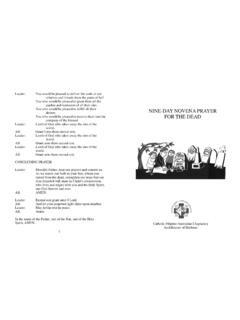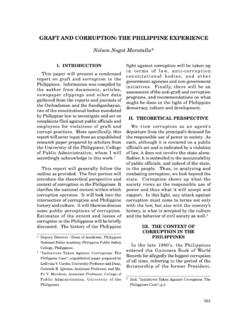Transcription of The history of Philippine theatre
1 The history of Philippine theatre Philippine THEATER Theater in the Philippines is as varied as the cultural traditions and the historical influences that shaped it through the centuries. The dramatic forms that flourished and continue to flourish among the different peoples of the archipelago include: the indigenous theater, mainly Malay in character, which is seen in rituals, mimetic dances, and mimetic customs; the plays with Spanish influence, among which are the komedya, the sinakulo, the playlets, the sarswela, and the drama; and the theater with Anglo-American influence, which encompasses bodabil and the plays in English, and the modern or original plays by Fihpinos, which employ representational and presentational styles drawn from contemporary modern theater, or revitalize traditional forms from within or outside the country.
2 The Indigenous Theater The rituals, dances, and customs which are still performed with urgency and vitality by the different cultural communities that comprise about five percent of the country s population are held or performed, together or separately, on the occasions of a person s birth, baptism, circumcision, initial menstruation, courtship, wedding, sickness, and death; or for the celebration of tribal activities, like hunting, fishing, rice planting and harvesting, and going to most rituals, a native priest/priestess, variously called mandadawak, catalonan,bayok, or babalyan, goes into a trance as the spirit he/she is calling upon possesses him/her. While entranced, the shaman partakes of the sacrificial offering, which may be a chicken, a pig, a carabao (depending on the gravity of the spirit s anger) or simply rice uncooked or in cakes, rice wine, and betel nut.
3 This act, which represents the death of the supplicant at the hands of the spirit, adapts itself to the occasion for which the ritual is the Tagbanua of Palawan in southern Philippines, the ritual of the diwata,which crowns a series of activities addressed to the spirits of ancestors, is held after the rice harvest on the last three days of the last moon, to ask the supreme deity Mangindusa, the other gods, and the spirits of ancestors for a bountiful harvest and for the well-being of the supplicants. For this most significant socioeconomic and religious event, the interior of the home of the babalyan is decorated with stripped palm leaves and bamboo slats with Tagbanua writing and designs.
4 In the center of the large room, the ritual offerings are carefully arranged: a small wooden boat hanging from the ceiling (on this the ancestors ride ); a mat on which are spread the bowls or plates of uncooked rice, jewelry, betel nuts, rice cakes (which are later consumed by the people), ginger, onions; a ritual bamboo swing which the babalyan rides or chants on; a stool on which are arranged more food offerings; and the all-important wine jars set in a line in front of the swing and provided with oil-rubbed straws through which the spirits will sip the rice wine (wine is not found in the spirit world so it is the one item that best attracts spirits to the celebration).To the heady music of gongs and drums, the babalyan s assistant, dressed in a sarong skirt, tight blouse, and sash from which the wavy long knife called karishangs, opens the ritual by performing several dances and shaking in both hands the ugsang (stripped palm leaves) with bells, in honor of Mangindusa who is supposed to be perched on the roof of the house.
5 This part ends with the babalyan letting out a scream and pulling the ceremonial staff attached to the ceiling to denote that Mangindusa has departed. Soon after, the babalyan herself, also in a similar skirt and blouse, but with a black hood covering her face, works herself into a trance, as she sips wine and swings herself in the middle of the room. Then she dances, balancing on her head a bowl with rice or a bowl with candles or a karis, while brandishing the palm leaves or two porcelain bowls or a piece of cloth in her two hands, as she is followed by an assistant. To the continued beating of the gongs, the babalyan may then shake the palm leaves violently and strike the sides of the wine jar angrily and sip wine, denoting that a spirit has come down.
6 As other spirits take turns possessing her, the babalyan s movements may change one spirit may prompt her to sip wine or softdrinks or water; another may want to smoke cigarettes with those participating in the ritual; others may dance with a long knife or bolo on their heads; or oil the women s hair; or lead the singing of the spirit song. The series of possessions is capped with those present drinking and smoking and participating in the activities of the ritual (Fox 1982).Interestingly, these animistic rituals survive today even among Christianized Filipinos. In Isabela, the atang-atang ritual of the Ibanag features a gaily decorated small bamboo raft with offerings of rice, oil, eggs, cigarettes, rice cakes, and a little chick representing the soul of the sick person.
7 Around this raft situated on the ground, two women dance, drink, and chant Christian prayers to cure the sick. Later, the women take oil from the raft and rub it on the face, legs or hands of the from rituals, tribal dances which were more often than not mimetic may also be considered as proto-dramas. A majority of these dances, which mark important events like baptism, courtship, marriage and even death, depict important tribal tribes of the Cordillera have dances that reenact the hunt for and the killing of a boar, as well as the practice and ways of headtaking; the Aeta of Zambales perform dances which show the techniques of gathering wild honey in the forest as well as hunting for fish; the Tausug of Sulu boast of dances that represent how oranges are picked or how not to catch a mudfish.
8 The most important dance, however, among most Philippine tribes is the war dance. The war dance of the Mansaka of Davao del Norte imitates the movements of model warriors called bagani, as the latter fight with spears, bolo, and tribal dances which may be considered proto-dramas as well are the dances which are playful imitations of animal movements, like the monkey, fish, and fly dances of the Aeta of Zambales in Luzon; the hawk dances of the Higaonon in mindanao ; and the butterfly, monkey, and bird dances of the Tausug and Sama in too are some of the customs associated with courtship, marriage, and death among the ethnic communities. Of the courtship customs, the most common is the debate between a male and a female, which may employ verse, song, and dance.
9 The Maranao panonoroon has a boy and a girl chanting metaphorical verses to each other, with the boy offering his love to the girl and the latter warding off his verbal advances. The Cebuano balitaw features antiphonal songs performed by male and female, which talks not only of love, but of the problems of married couples and rural workers. Among the Tagalog, the debate in song and dance becomes an exchange of spoken verses in the duplo, where poets called bilyako use proverbs, riddles, the pasyon, and the awit as well as contemporary events to advance their suits to the bilyaka of their choice. In the 1920s, the duplo became a formal debate on an issue, and was called the customs related to weddings include: the Tagalog pamanhikan, where representatives of the families of both the boy and the girl speak in metaphorical language to settle the dowry or bridal price; and the Bilaan samsung, where, after the bride-price is paid, the bride and the groom are forced to sit beside each other, and their hair tied together even if the bride objects.
10 Finally, mimetic customs related to death are, exemplified by the baraning usa of the Aeta of Camarines, where a deer made of banana stalk and twigs hunted down and offered to the dead to take to the next a whole, indigenous dramas are well integrated into the lives of tribal Filipinos. These rituals, dances, and customs express their very beliefs and depict their activities and material culture. Furthermore, they help fulfill the basic needs of the tribe for a good harvest and victory in war, as well as the physical and spiritual well-being of the sick, the newly born, the youth, and the newly wed members of the tribe. Finally, these plays bind the members of the tribe in a stronger bond for the common good.







